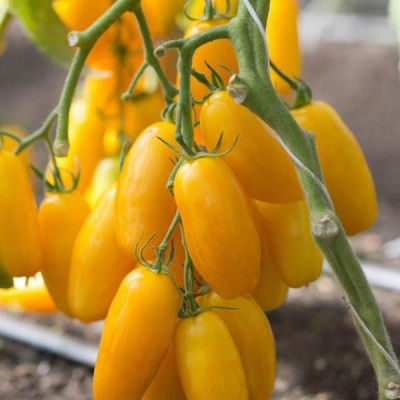
- Authors: LLC 'AGROFIRMA POISK'
- Year of approval: 2015
- Category: grade
- Growth type: indeterminate
- Appointment: fresh consumption, for pickling and canning, for ketchup and tomato paste
- Ripening period: mid-season
- Ripening time, days: 105-115
- Growing conditions: for film greenhouses
- Bush size: tall
- Bush height, cm: 300
An excellent representative of yellow-fruited varieties is the indeterminate yellow banana tomato. The universal variety got its name due to the color and elongated shape of the fruit. Designed so that it can be grown in greenhouses and in the garden, it is used for fresh consumption, with whole-fruit canning, for the preparation of original ketchups and sauces.
Breeding history
The variety was bred by Agrofirma Poisk LLC. Year of Approval 2015.
Description of the variety
Tall indeterminate, up to three meters, the bushes are covered with medium-sized lace wrinkled light green leaves, in need of support or trellis. Shoots form simple intermediate inflorescences; fruits are attached to a strong articulated stalk. The first inflorescence is laid after 7 leaves, all subsequent ones after two. From 10 ovaries are formed on one brush.
Advantages | disadvantages |
Decorativeness | The need for shaping and pinning |
Dessert taste | Variety needs growth restriction |
Stable yield | |
Allowed for allergy sufferers | |
Cracking resistance | |
The fruits are well stored for a long time and are suitable for transportation. | |
The growth point must be pinched upon reaching the required height, in this case, all nutrients are redirected to the tomatoes, which contributes to their active filling.
The main qualities of the fruit
Banana-shaped or cylindrical fruits of medium size and weighing 80-120 grams are colored in a light green uniform color, turning into lemon-yellow at the stage of technical ripeness. The dense, glossy skin contributes to long-term storage and good transportation.
Taste characteristics
Tomato pulp has a medium density structure, characteristic aroma, balanced sweet taste, and a high content of vitamins and minerals.
Ripening and fruiting
The mid-ripening variety is remarkable for the amicable ripening of fruits on days 105-115. The harvest begins at the end of August - in September.
Yield
The variety is considered a medium-yielding variety and consistently yields up to 6.8 kilograms per square meter, 3-5 kg per bush.
The timing of planting seedlings and planting in the ground
After 55-65 days after sowing seeds for seedlings, the plants are planted in open ground. They are transplanted into the greenhouse much earlier - the timing depends on the region and climatic conditions.

Growing tomato seedlings is an extremely important process, because it largely depends on whether the gardener can harvest at all. All aspects must be taken into account, from seedbed preparation to planting in the ground.
Landing scheme
When transplanting to a permanent place, experts advise adhering to the traditional planting scheme of 40 x 60 cm.

Growing and care
For disinfection, seeds are treated with special stimulant solutions (Epin extra, Zircon, HB 101 and others), which contributes to strong immunity and active development of plants. Seedlings are grown in the traditional way, with supplementary lighting with a phytolamp, if there is not enough natural light. After 55-65 days, young plants are transplanted into greenhouses and vegetable gardens, choosing soils with a neutral pH level. The tomato needs pinching and the formation of bushes in 1-2 stems.
When cultivating crops in a greenhouse, it is necessary to remember to maintain an optimal microclimate. On hot days, ventilation is obligatory, sometimes even shading, so that the plants do not "burn out". It is also important to observe the level of humidity of the air and soil, in order to avoid the appearance of late blight.
Growing in a vegetable garden is somewhat different from greenhouse methods. Sunny places are chosen for planting, since the southern culture is characterized by an increased dependence on the sun. The wells are prepared in advance, enriching the removed soil with organic matter, superphosphate, river sand, if the soil is not loose enough. Support cultivation requires simultaneous installation of support stakes in the pits. Tapestries, as a rule, are made thoroughly, once and for a long time. After planting, the soil is compacted, well shed. Care procedures include watering, weeding, loosening, fertilizing with nitrogen phosphorus-potassium fertilizers.




A plant needs different micronutrients at each stage of growth. All fertilizers can be divided into two groups: mineral and organic. Folk remedies are often used: iodine, yeast, bird droppings, eggshells.
It is important to observe the rate and period of feeding. This also applies to folk remedies and organic fertilizers.
Disease and pest resistance
Banana yellow has good resistance to viral tobacco mosaic (TMV), and is rather unstable to other diseases. In order to prevent damage by fungal diseases and pests, preventive treatments with insecticides and fungicides are necessary. Some gardeners who avoid using chemicals on their site prefer home remedies, for example, a strong concentration of laundry soap.


Resistant to adverse weather conditions
In this regard, the variety has average performance - it tolerates summer daily temperature drops well, but responds poorly to prolonged rains.
Growing regions
Tomato is well cultivated in all regions of the country, except for the Arctic. These are the North, North-West, Central, North-Caucasian, Volgo-Vyatka, TsChO, Middle Volga, Nizhnevolzhsky, Ural, West Siberian, East Siberian, Far Eastern regions.

























































































